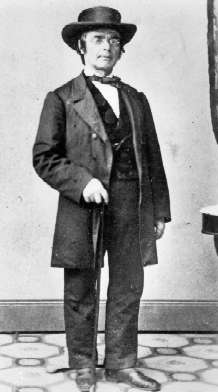Henry E. Steinway
| Henry E. Steinway | |
|---|---|
 Henry E. Steinway. This studio photo was taken by Mathew Brady, a noted civil war photographer. | |
| Born |
Heinrich Engelhard Steinweg February 15, 1797 Wolfshagen im Harz, Brunswick-Wolfenbüttel, Holy Roman Empire (now Langelsheim, Lower Saxony, Germany) |
| Died |
February 7, 1871 (aged 73) New York, New York, United States |
| Occupation | Piano manufacturer |
| Known for | Founding the piano company Steinway & Sons |
Heinrich Engelhard Steinweg, anglicized name Henry Engelhard Steinway (February 15, 1797 – February 7, 1871) made pianos in Germany and the United States.[1] He was the founder of the piano company Steinway & Sons.[2]
Early life
Steinway was born Heinrich Engelhard Steinweg in Wolfshagen im Harz, Duchy of Brunswick in the Holy Roman Empire of the German Nation (modern Germany).[2][3] His childhood was marked by many tragedies and twists of fate. He attended public school in his home town. At the age of 8, he was an orphan and thrown upon his own resources, until his father and brothers, once thought to have been killed in action, returned and claimed him once more. Then, at 15, he was orphaned once again, and it was at this time that he joined the German Army.[2] In 1814, he joined the Schwarze Schar, the volunteer corps of Frederick William, Duke of Brunswick-Wolfenbüttel in the war against Napoleon's occupation of parts of Germany but remained in the garrison throughout the Napoleonic War campaign of the Hundred Days in 1815.[3]
Career
He left service on 23 June 1822 and began to work as a carpenter, and later he became an apprentice to an organ builder in the town of Goslar. He soon discovered his love for music and became an organ player in the church.
He started building instruments, though hidden in the kitchen of his house because of the strong rules of the guild. In Braunschweig, he started by building guitars and zithers, and then graduated to pianos, of small proportions initially and gradually increasing in size.
In 1835 he made the first square piano, which he presented to his bride Juliane at their wedding. In 1836 he built his first grand piano in his kitchen in the town of Seesen. This piano was later named the "kitchen piano", and is now on display at the New York Metropolitan Museum of Art with a Steinweg 1836 square piano.[4] In 1839, he exhibited three pianos at the state trade exhibition in Braunschweig, Germany and was awarded a gold medal.[5]
Because of the unstable political climate following the revolutions of 1848 in the German states and the limited economic opportunities for a man working outside a guild,[6] Steinweg decided to leave the country. He emigrated from Braunschweig to New York City in 1850 with five of his sons,[7] but before leaving he gave the company to his son, Christian Friedrich Theodor Steinweg. Later in New York, he anglicized his name to Henry E. Steinway upon advice from friends, who concluded that the German surname Steinweg would be disadvantageous for doing business. Steinway and his sons worked for other piano companies until they could establish their own production under the name of Steinway & Sons in 1853.
The overstrung scale in a square piano earned the Steinway Piano first prize at the New York Industrial Fair of 1855. In 1862 they gained the first prize in London in competition with the most eminent makers in Europe; and this victory was followed in 1867 by a similar success at the Universal exposition in Paris. According to Franz Liszt, Anton Rubinstein, and other high authorities, the Steinways have done more to advance the durability, action, and tone-quality of their instruments than any other makers of Europe or America.[2]
Personal life
He and his wife, Juliane, had seven children:[8]
- Albert Steinway
- Charles H. Steinway
- C.F. Theodore Steinway (1825–1889)
- Doretta Steinway
- Henry Steinway, Jr.
- Wilhelmina Steinway
- William Steinway (1835–1896)
Steinway died in New York City, United States, on February 7, 1871.[2]
References
- ↑ Henry Engelhard Steinway." Encyclopædia Britannica. Encyclopædia Britannica Online. Encyclopædia Britannica, 2011. Web. 15 Feb. 2011. <http://www.britannica.com/EBchecked/topic/565063/Henry-Engelhard-Steinway>.
- 1 2 3 4 5
 Wilson, James Grant; Fiske, John, eds. (1900). "Steinway, Henry Engelhard". Appletons' Cyclopædia of American Biography. New York: D. Appleton.
Wilson, James Grant; Fiske, John, eds. (1900). "Steinway, Henry Engelhard". Appletons' Cyclopædia of American Biography. New York: D. Appleton. - 1 2 Biography at Allgemeine Deutsche Biographie (German)
- ↑ "Steinway History", Steinway & Sons Official Website. Accessed February 8, 2010. Archived January 3, 2010, at the Wayback Machine.
- ↑ Hoover, Cynthia Adams (1981). "The Steinways and Their Pianos in the Nineteenth Century". Journal of the American Musical Instrument Society. Shreveport, Louisiana: American Musical Instrument Society. 7: 51. ISSN 0362-3300.
- ↑ Torp, Claudius. "Heinrich Engelhard Steinway." In Immigrant Entrepreneurship: German-American Business Biographies, 1720 to the Present, vol. 2, edited by William J. Hausman. German Historical Institute. Last modified October 10, 2013.
- ↑ Klueber, Karl Werner. "Der erste deutsche Ozeandampfer machte nur drei Ueberfahrten." In Genealogie, vol. 8:3 (Mar. 1967), p. 660.
- ↑ Lieberman, Richard K. (1995). Steinway & Sons. New Haven: Yale University Press. ISBN 0-300-06364-4. pp. 14-15.
External links
- Steinway & Sons – European and worldwide headquarters
- Steinway & Sons – American headquarters
- The Steinway & Sons Collection in La Guardia and Wagner Archives
